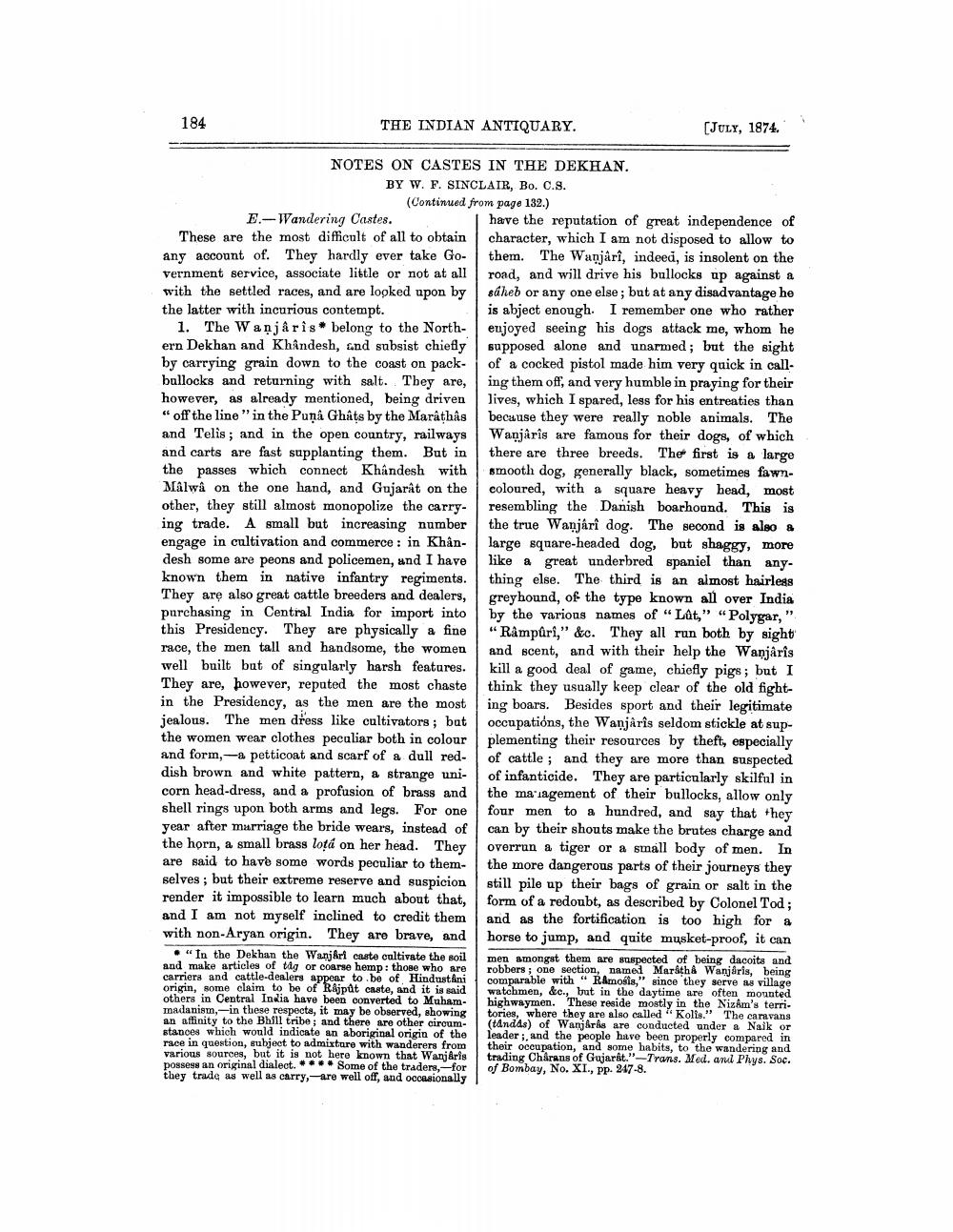________________
184
THE INDIAN ANTIQUARY.
NOTES ON CASTES IN THE DEKHAN. BY W. F. SINCLAIR, Bo. C.S. (Continued from page 132.)
E-Wandering Castes.
These are the most difficult of all to obtain any account of. They hardly ever take Government service, associate little or not at all with the settled races, and are looked upon by the latter with incurious contempt.
1. The Wanjârîs belong to the Northern Dekhan and Khandesh, and subsist chiefly by carrying grain down to the coast on packbullocks and returning with salt. They are, however, as already mentioned, being driven "off the line " in the Punâ Ghâts by the Marâthâs and Telis; and in the open country, railways and carts are fast supplanting them. But in the passes which connect Khandesh with Mâlwâ on the one hand, and Gujarât on the other, they still almost monopolize the carrying trade. A small but increasing number engage in cultivation and commerce in Khândesh some are peons and policemen, and I have known them in native infantry regiments. They are also great cattle breeders and dealers, purchasing in Central India for import into this Presidency. They are physically a fine race, the men tall and handsome, the women well built but of singularly harsh features. They are, however, reputed the most chaste in the Presidency, as the men are the most jealous. The men dress like cultivators; but the women wear clothes peculiar both in colour and form, a petticoat and scarf of a dull reddish brown and white pattern, a strange unicorn head-dress, and a profusion of brass and shell rings upon both arms and legs. For one year after marriage the bride wears, instead of the horn, a small brass lotá on her head. They are said to have some words peculiar to themselves; but their extreme reserve and suspicion render it impossible to learn much about that, and I am not myself inclined to credit them with non-Aryan origin. They are brave, and
"In the Dekhan the Wanjari caste cultivate the soil and make articles of tag or coarse hemp: those who are carriers and cattle-dealers appear to be of Hindustani origin, some claim to be of Rajput caste, and it is said others in Central India have been converted to Muhammadanism,-in these respects, it may be observed, showing an affinity to the Bhill tribe; and there are other circumstances which would indicate an aboriginal origin of the race in question, subject to admixture with wanderers from various sources, but it is not here known that Wanjaris possess an original dialect. Some of the traders,-for they trade as well as carry, are well off, and occasionally
[JULY, 1874.
have the reputation of great independence of character, which I am not disposed to allow to them. The Wanjârî, indeed, is insolent on the road, and will drive his bullocks up against a saheb or any one else; but at any disadvantage he is abject enough. I remember one who rather enjoyed seeing his dogs attack me, whom he supposed alone and unarmed; but the sight of a cocked pistol made him very quick in calling them off, and very humble in praying for their lives, which I spared, less for his entreaties than because they were really noble animals. The Wanjârîs are famous for their dogs, of which there are three breeds. The first is a large smooth dog, generally black, sometimes fawncoloured, with a square heavy head, most resembling the Danish boarhound. This is the true Wanjârî dog. The second is also a large square-headed dog, but shaggy, more like a great underbred spaniel than anything else. The third is an almost hairless greyhound, of the type known all over India by the various names of "Lût," "Polygar, " "Râmpuri," &c. They all run both by sight and scent, and with their help the Wanjârîs kill a good deal of game, chiefly pigs; but I think they usually keep clear of the old fighting boars. Besides sport and their legitimate occupatións, the Wanjârîs seldom stickle at supplementing their resources by theft, especially of cattle; and they are more than suspected of infanticide. They are particularly skilful in the management of their bullocks, allow only four men to a hundred, and say that they can by their shouts make the brutes charge and overrun a tiger or a small body of men. In the more dangerous parts of their journeys they still pile up their bags of grain or salt in the form of a redoubt, as described by Colonel Tod; and as the fortification is too high for a horse to jump, and quite musket-proof, it can
men amongst them are suspected of being dacoits and robbers; one section, named Maratha Wanjâris, being comparable with "Ramosis," since they serve as village watchmen, &c., but in the daytime are often mounted highwaymen. These reside mostly in the Nizâm's territories, where they are also called "Kolis." The caravans (tandas) of Wanjârâs are conducted under a Naik or leader;, and the people have been properly compared in their occupation, and some habits, to the wandering and trading Charans of Gujarat."-Trans. Med. and Phys. Soc. of Bombay, No. XI., pp. 247-8.




